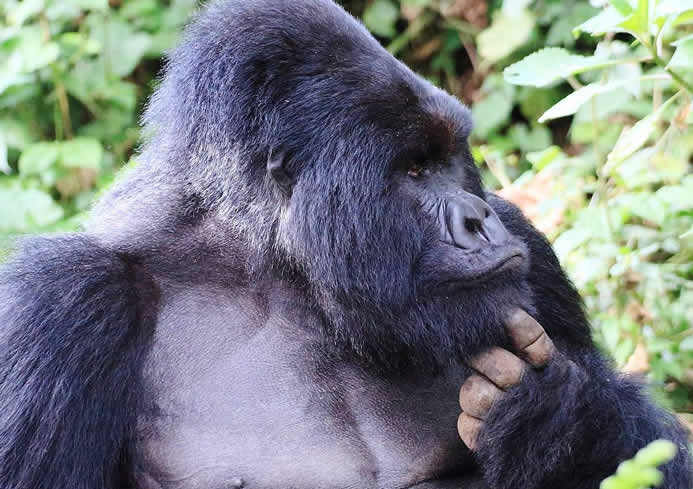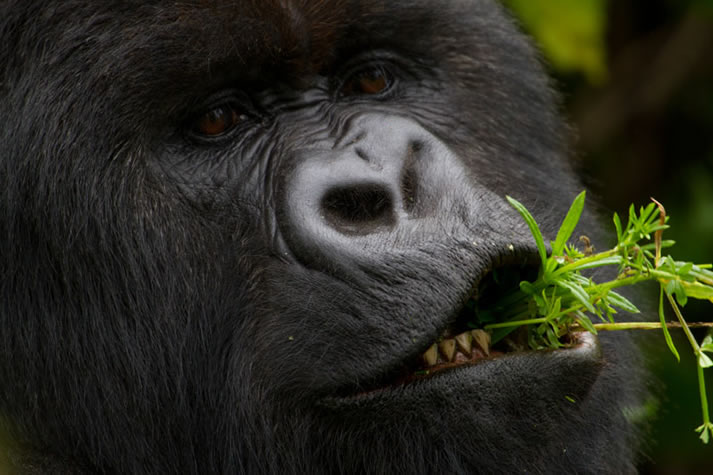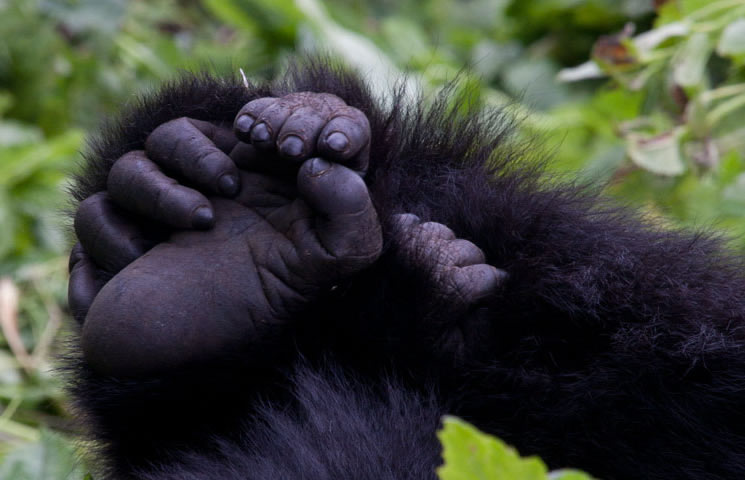A Call to Save Mountain Gorilla of Africa
Scientifically known as Gorilla Beringei beringei, the Mountain Gorilla is a sub species of the East Gorilla and a member of the great apes family. It is one of the last 4 surviving Gorilla sub species with the other 3 being the Eastern low land and Western low land gorillas as well as the Cross River gorilla in West Africa and it is the 2nd largest of all the primates after their sister subspecies; the Eastern low land gorilla.

The mountain gorillas live in large groups or families composed of females and their young ones with one dominant male known as Silver back because of its silver lining that cuts across its back and hips that develops between the ages of 12-15 years.
As the name suggests, the mountain gorillas often inhabit montane and bamboo forests in high altitudes at elevations of about 8000-13000 ft where they feed mainly on leaves, stems and shoots. As a result of the cold and harsh temperatures at such elevations, these gentle giants have developed thicker and more fur than their sister sub species in order to insulate their bodies against such coldness.
Males, weigh an average weight of 195 kg (430 lb), almost twice the weight of females and have an upright standing height of 150 cm (59 in) while females reach an average height of 130 cm. The eyes and ears are dwarfed by its large head and hairless, shiny black muzzle. Older males develop a crown of muscle and hair that makes the head look even longer. The arms are longer than the stubby legs.
Mountain gorillas have a slow rate of reproduction. Females give birth for the first time at about the age of 10 years and will then produce at an average interval of three to four years. A male becomes sexually mature between 12 and 15 years, when he is in charge of his own group. A female is able to conceive for only about three days each month and produces a single young one, which is weak and tinny weighing about 4 pounds.

Though the newly borns have limited movements like those of human babies, their rate of development is almost twice faster and at 3 to 4 months it can see up right. The baby gorillas are weaned at about 3 and half months when they become more independent.
Mountain Gorillas live in small islands of Mountain Tops amidst oceans of human settlement, which puts their survival at stake due to their constant conflict as they compete for an ever -reducing space.
The remaining population of this sub species spans the small corridor of the Virunga Massif that covers 3 national parks of Virunga NP (DR Congo), Mgahinga Gorilla park (Uganda) and Volcanoes NP (Rwanda) and the Bwindi impenetrable National park in Uganda. It is however; not clear whether these apes once lived across the entire planet but one thing that is well known is that they currently exist in only the mentioned areas and no historic trace of survival in captivity.
Mountain gorillas are descendants of ancestral monkeys and apes found in Africa and Arabia during the start of the Oligocene epoch (34-24 million years ago). The fossil record provides evidence of the hominoid primates (apes) found in east Africa about 22–32 million years ago.
As primates, humans and gorillas share a common ancestor. Humans did not evolve from gorillas as some people would assume, but rather took separate evolutionary paths about 10 million years ago. We appear to have a special kinship with these animals despite our physical differences.
Since the fossil record of the habitat of the Mountain gorillas is particularly poor, their evolutionary history has remained unclear. About 9 million years ago, the group of primates that were to evolve into gorillas split from their common ancestor with humans and chimps and the genus Gorilla emerged. It is not certain what this early relative of the gorilla was, but it is traced back to the early ape Proconsul africanus.
Though these great apes have been perceived to be fearful especially for those that have watched the popular movies like ‘King Kong’, research has proved them to be rather peaceful and playful. Large males play along with babies and allow them unlimited access to their bodies as some climb them and engage them in play. Mountain gorillas do not attack humans unless when irritated, may act in self defense
Following their first scientific discovery in 1902 by the German explorer; Oscar von Beringe, who became the first non- African to see the then yet to be threatened primate, the future of the mountain gorilla was yet to hang in balance.

Conservation history
The period that followed their fateful discovery, the mountain gorilla population faced turbulent times as one Gorilla researcher; George Schaller wrote; ‘No one who looks into a gorilla’s eyes — intelligent, gentle, vulnerable — can remain unchanged, for the gap between ape and human vanishes; we know that the gorilla still lives within us. Do gorillas also recognize this ancient connection?’
They were often short and killed or captured a live and taken as trophies by American and European hunters and collectors. With in a period of 25 years, more than 50 mountain gorillas had been taken as trophies or for collections. The future of their survival was steadily accelerating into a somber history and their chances of survival to the next generation were seemingly becoming an illusion.
A case in point was Carl Akeley of the American Museum of Natural History who short five gorillas in 1921 but as a species chosen by its creator to see the next day, the same tormentor was yet to become their messiah when he convinced the Belgium government that was in charge of the then Zaire to establish what was yet to be Africa’s first national park.
Poaching continued to claim most of the mountain gorillas in the Virunga region and the population of a species that was newly discovered showed signs of complete extinction. In 1925, the Virunga NP was gazetted by the Belgian government to conserve these apes but the park was too young to protect the life of a creature that had attracted attention of the world as poachers intensified their works.
When the civil war broke out around 1960, park protection vanquished and gorillas were being killed by snares intended for other animals for their meat and some were directly targeted for their body parts as well as for meat by the roaming rebel groups in the area. In 1968, 40 percent of the remaining forest was turned over to a European-sponsored agricultural scheme.
Fortunately, the mid 20th Century brought a dawn of hope in the life of the mountain Gorillas thanks to the efforts of conservationists like Carl Akeley, George Schaller and Dian Fossey who popularized the plight of this ape to the entire world and advocated for its survival.
In 1963, Dian Fossey, an American zoologist started her research about the life of the mountain gorilla high in the Virunga mountains that later culminated into her book, ‘Gorillas in the Mist’ that inspired the 1988 movie that attracted attention world over.
This female doctor despite challenges of language barrier and lack of manpower traversed the gorilla territory, rescuing trapped gorillas and fighting poaching. She was later forced to flee for her life from Congo as civil conflict erupted in the north Kivu province and she carried her research projects to Rwanda.
She later started a research institute at a place between Mt. Karisibi and Bisoke that was later to be known as Karisoke research center. Her dedication in the fight for the survival of the mountain gorillas climaxed into her loss of life presumably at the hands of the same poachers that she paused a threat to, as she was found brutally murdered in her tent in 1985. Her remains were buried next to the grave of her beloved gorilla friend called Digit that had been killed by poachers
The year 1970, turned a new page in the life of the mountain Gorilla with the international consortium of conservation organizations establishing the Mountain Gorilla Project to bring gorilla tourism to the area and educate Rwandans about the gorillas. The impact was to be soon felt in the other stakeholder countries of Congo and Uganda.
Some conservation organizations took shape and joined hands to fight for the fate of the then yet -to -be extinct creature. After the death of Dian Fossey in 1985, Ruth Keesling chose to keep the fire burning and indeed the ball that Dian set rolling never came to stop.
Keesling kick started the Save a Gorilla organization that championed several projects aimed at conserving these gentle giants among which was the Mountain Gorilla conservation fund and the much recent Gorilla doctors project. More organizations like African Wildlife Foundation, Flora and Fauna International and World Wildlife Organization have since then been working to the rescue of Mountain gorillas.
In 1991, World Wildlife Organization together with Flora and Fauna International, African Wildlife Foundation and the 3 governments of Uganda, Rwanda and Congo founded the International Gorilla Conservation Programme that focused on monitoring the mountain gorillas and teaching the local communities how to conserve these gentle giants as well as harmonizing their interests to promote peaceful co-existence.
It is upon this background and tireless efforts of several conservationists together with the local population that the Mountain Gorilla conservation is regarded as the most successful recovery story ever told.
With a staggering number of 248 individuals left in the world at the time of Dian Fossey’s death, the mountain gorilla could have gone the dinosaur way had it not been this relentless work of the conservationists.
Thumbs up for the local communities around the Mountain gorilla habitat for their untiring efforts and cooperation to keep this most sought after creature
alive. It is because of their cooperation that the once threatened species of great apes now numbers not fewer than 880 individuals as per the 2011 census with about 400 individuals in Bwindi and the remaining distributed among the 3 parks of Mgahinga, Volcanoes and Virunga that make the Virunga Massif.
Gorilla tourism has now taken shape, which has further enhanced the conservation of Mountain Gorillas. The money got from the sale of permits is directly put back in conservation programs as well as improving the lives of the people in neighboring communities.
The Gorilla permit; which allows some one to visit gorillas in Africa for a maximum of 1- hour costs USD500 per person for Congo, USD750 per person for Rwanda and USD600 per person for Uganda
In a bid to ensure their safety, the three governments came up with a set of rules that one must follow during your gorilla safari , among which is the 10m- away rule that is intended to prevent humans from infecting these apes with illnesses. It should be noted that although these giants look physically strong, their immunity is not that strong as a mere cold can claim a life among its population
With the existence of the Wildlife Animal Resources Management department at Makerere University in Uganda under the partnership with Ruth Keesling, several doctors have been trained who have gone a head to help in treating the mountain gorillas and making more comprehensive research about the lives of these creatures and how to guard them against different diseases.
Their works have been energized by the Gorilla doctors another project spearheading research for new medicines and treatment of these gentle apes.
The Gorilla naming ceremony in Rwanda known as the ‘Kwita iziina’ is now an annually celebrated event intended to raise awareness about the mountain gorilla conservation and visible results have been realized. Several dignitaries and other tourists often flock Rwanda in June to attend this ceremony where the guests are given a chance to name the newly born baby mountain gorillas
Although all this effort has been put in place, the fate of the mountain gorilla remains threatened especially by the growing population and human pressure on its habitat, which calls for continued efforts and vigilance. Forests are still being encroached on though the governments of the 3 countries remain committed to protecting the future of this gentle giant.
Human population pauses the major threat to the existence of Mountain gorillas through habitat loss and climate change as the result of our actions like Oil mining in the Virunga.
Gorillas, like all other animals, are significant in maintaining balance in the ecosystem. Without the gorillas, which are large-scale grazers, eating a variety of vegetation, the natural balance in the food chain would be disrupted. This could negatively affect other wildlife, their habitats, and ultimately the people who depend on that environment for food, water and other resources.
By protecting mountain gorillas, we’re helping make sure their environment remains healthy for the people and other wildlife that depend on it.
Ecotourism – socially and environmentally responsible tourism, including carefully guided tours to spot gorillas – can also be an important way for local people to earn a living. One mountain gorilla can indirectly generate £2.5 million over its lifetime from tourist income. This therefore insinuates that conserving this gentle ape means a better life for those living in these respective nations hence making this effort, every one’s obligation. Let us save this iconic creature!
Uganda Tours & Gorilla Safaris
- 2 Days Bwindi Gorilla safari
- 3 Days Gorilla Tour in Uganda
- 3 Days Lake Mburo wildlife
- 3 Days Murchison Falls Park
- 4 Days Gorilla Double Trekking
- 4 Days Gorilla & Wildlife Tour
- 5 Days Gorilla Watching Safari
- 6 Days Primates, Gorillas, Wildlife
- 7 Days Honeymoon Safari
- 10 Days Uganda Safari Highlights
Rwanda Gorilla Trekking
- Uganda Gorilla Trekking Guide
- 2 Days short gorilla tour
- 3 Days Rwanda Gorilla Safari
- 4 Days Mountain Gorilla Tour
- 5 Days Honeymoon Rwanda
- 7 Days Rwanda Tour
- 8 Days Best of Rwanda Safari